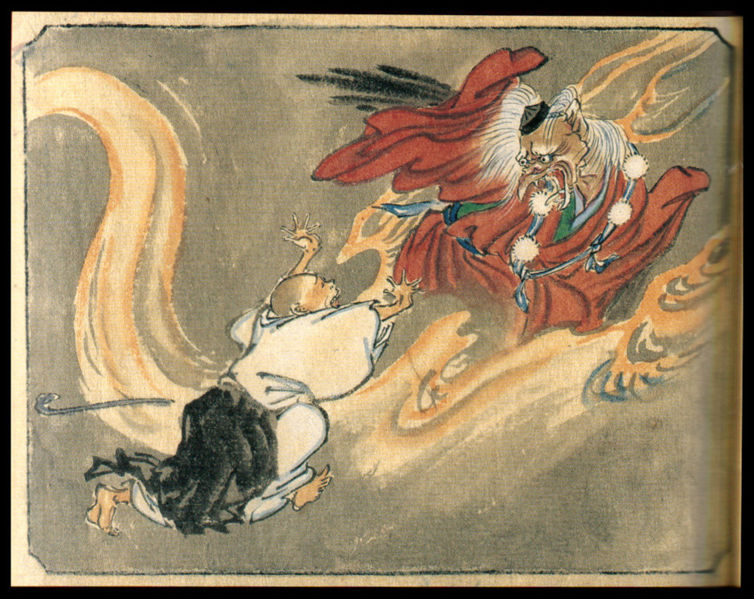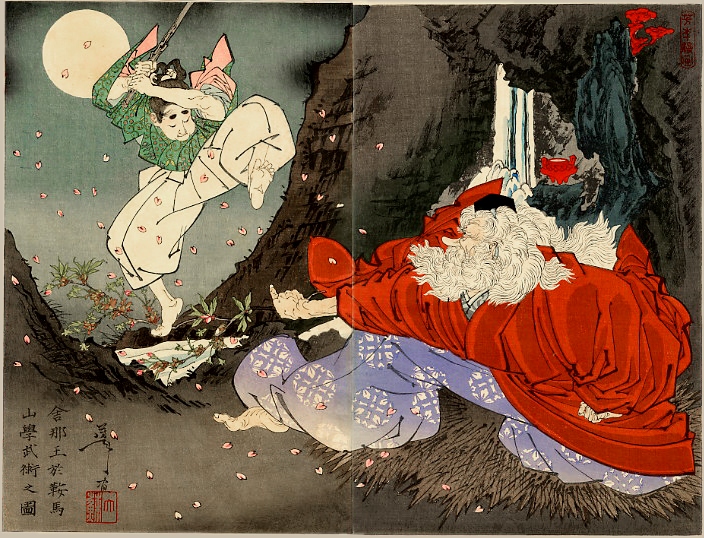Ian Ropke writes:
The mountains throughout Japan are home to a very long-nosed creature known as a tengu or mountain goblin. The origins of tengu are not very clear. They can be found in both Shinto and Buddhist texts. Some scholars trace the origin of the tengu to one of the primary gods of Shinto: Susano-o, who shares many of the characteristics for which tengu are feared and celebrated. Others say the idea of tengu came from China where a similar mischievous mountain spirit has long preyed on men in similar ways. Regardless of their origins, tengu are feared and regarded as real. Even as late as the mid 19th century, government officials from Edo routinely put up official notices asking the tengu to leave a certain mountain area or to at least behave as the shogun was coming to visit.

Tengu are known to have an unusual sense of humor: they like to destroy things built in the mountains that show or are home to excessive human pride or arrogance, especially by burning them down. They are also especially fond of tormenting arrogant Buddhist priests that came to some remote mountain slope to study. They love to make fools of those who by their very arrogance or pride are clearly being foolish.
According to some, tengu have long noses because they were arrogant priests or samurai warriors in their last human life cycle. Some say that a tengu that does good deeds can be reborn as a normal human being again. The Japanese expression, “Tengu ni naru†meaning don’t be arrogant or you will become a tengu in your next lifetime.
There are two main types of tengu goblins: the ancient karasu or raven tengu and the more human-like yamabushi (religious mountain ascetics or hermits) tengu. Karasu tengu, much like the animal they are named after, are the most mischevious of the two. They are the ones that like to kidnap children from mountainous areas, start fires and take revenge on anyone who ruins the forests that they live in. The tamer version of the karasu tengu is the yamabushi tengu. These tengu are more friendly to human and serve as wise councilors in the affairs of men. Many yamabushi were thought to possess magical powers derived from their ascetic practices and the sacredness of the mountains themselves. Over time, the folklore of tengu and yamabushi became intertwined.
Tengu, like many supernatural beings the world over, can change their form when it pleases Unlike ghosts, tengu are always shown in paintings and drawings with feet which are usually wrinkled all over to indicate that they are very old. Like ghosts, tengu can take on the form of a human being, usually old men or women with long noses to deceive or otherwise take advantage of people. Other supernatural Japanese creatures like foxes (kitsune) and badgers (tanuki) can also change their forms but their shadow or reflection shows their true self. If a tengu is temporarily knocked out through the actions of a powerful warrior or with powerful magic it will turn into a wounded raven.
In art or literature, the tengu is often used to criticize established or new, powerful Buddhist hierarchies. Tengu hate excessive arrogance, pride and prejudice. They are therefore also depicted and respected for the role they play in protecting the Dharma (Buddhist law). Corruption among monks living in rich, protected Buddhist monasteries often resulted in those individuals become yamabushi tengu after they had died.

Tengu are often connected to the martial arts of Japan. They are said to be super skillful with a sword and equally gifted at forging the finest weapons. And throughout history, particularly strong, essentially “goodâ€, tengu have been credited with turning merely strong fighters into super warriors.
Mount Kurama just north of Kyoto is a special place for tengu. It is the home of Sojobo, the so-called King of the Tengu. He is credited with training the young samurai warrior Minamoto Yoshitsune in sword fighting in the 12th century. Later Yoshitsune and his brother, Yoritomo, combined their talents and virtually wiped out the Taira clan and went on to establish the military capital of Japan in Kamakura, outside of present-day Tokyo. Today, if you go to Kurama you will see tengu masks in many of the gift shops and restaurants in the village. As this area is charged with mysterious energy, you may even feel a tengu is behind the next tree as you make your way through a thick forest alone.
Text by Ian Ropke. Ian Ropke is the author of the Historical Dictionary of Osaka and Kyoto, editor of Kyoto Visitors Guide, and director of Your Japan Private Tours. You can read his previous articles for Deep Kyoto here.